Refraction of Waves (DP IB Physics) : Revision Note
Snell's Law
Snell’s law relates the angle of incidence to the angle of refraction at a boundary between two media
Refractive Index
The refractive index, n of a material tells us how optically dense it is
The refractive index of air is n = 1
Media that are more optically dense than air will have a refractive index of n > 1
Media that are less optically dense than air will have a refractive index of n < 1
The higher the refractive index of a material then the more optically dense and hence the slower light will travel through it
The refractive index of a material is calculated using the equation:
Where:
n = absolute refractive index of the medium
c = speed of light in a vacuum in metres per second (m s–1), 3.00 × 108 m s–1, as given in the data booklet
v = speed of light in the medium in metres per second (m s–1)
Note that, being a ratio, the absolute refractive index is a dimensionless quantity
This means that it has no units
Snell's Law
Snell’s law is given by:
Where:
n1 = the refractive index of material 1
n2 = the refractive index of material 2
θ1 = the angle of incidence of the ray in material 1
θ2 = the angle of refraction of the ray in material 2
v1 = the speed of the wave in material 1
v2 = the speed of the wave in material 2
Snell's Law describes the angle at which light meets the boundary and the angle at which light leaves the boundary, so that the light travels through the media in the least amount of time
Light can travel through medium 1 at a speed of v1 due to the optical density n1 of that medium
Light will approach the boundary at angle θ1
This is the angle of incidence
Light can travel through medium 2 at a speed of v2 due to the optical density n2 of that medium
Light will leave the boundary at angle θ2
This is the angle of refraction
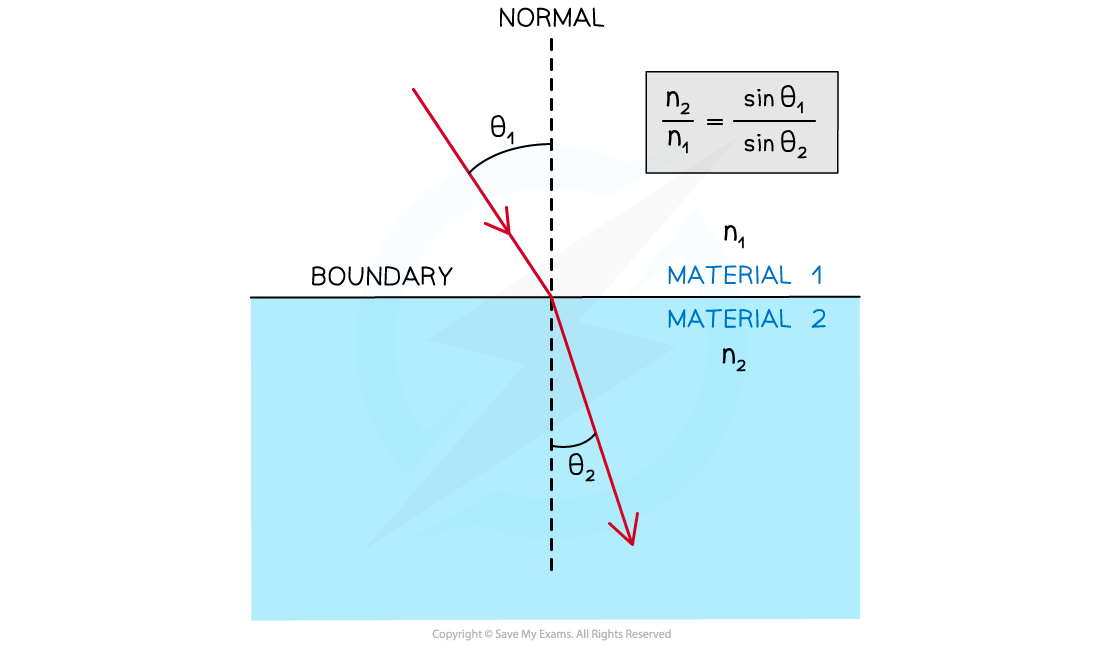
Snell's Law
Snell's Law can also be given in a more convenient form:
Worked Example
Wavefronts travel from air to water as shown. Add the refracted wavefronts to the diagram.

Answer:
Step 1: Add the incident ray to mark the direction of the incident waves
The incident ray must be perpendicular to all wavefronts
Remember to add an arrow pointing towards the air-water boundary

Step 2: Add the normal at the point of incidence
Mark the angle of incidence (i) between the normal and the incident ray
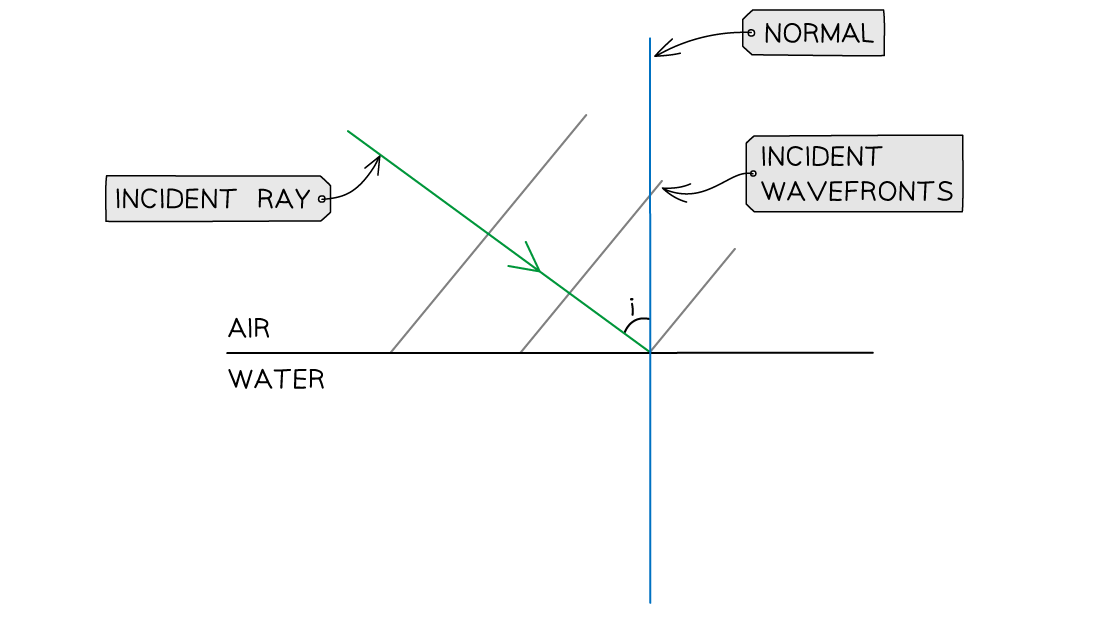
Step 3: Draw the refracted ray into the water
Water is optically denser than air
The refracted ray must bend towards the normal
Mark the angle of refraction (r) between the normal and the refracted ray
By eye, i > r
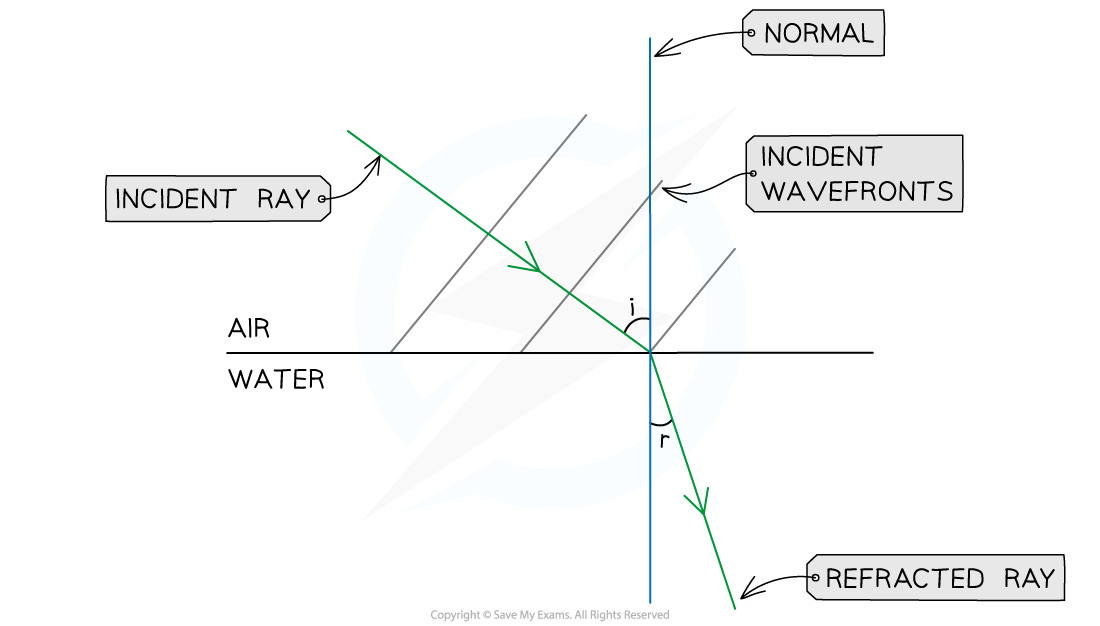
Step 4: Add three equally spaced wavefronts, all perpendicular to the refracted ray
The refracted wavefronts must be closer to each other than the incident wavefronts, since:
The speed v of the waves decreases in water
The frequency f of the waves stays the same
The wavelength λ of the waves in water is shorter than the wavelength of the waves in air λW < λA, since v = fλ
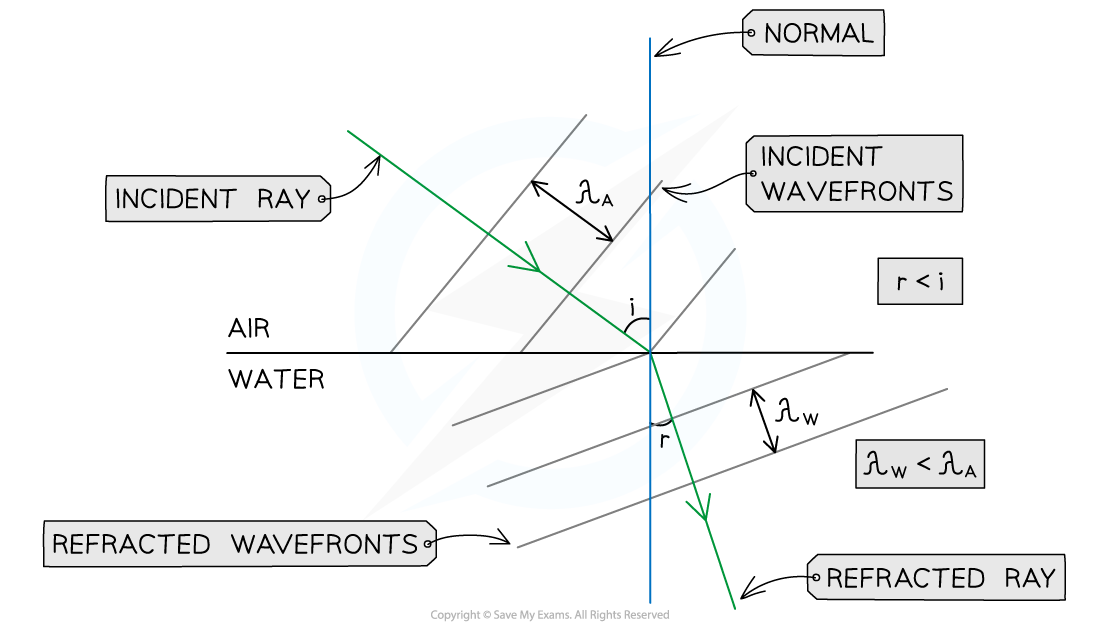
Worked Example
Light travels from air into glass. Determine the speed of light in glass.
Refractive index of air, n1 = 1.00
Refractive index of glass, n2 = 1.50
Answer:
Step 1: Write down the known quantities
n1 = 1.00
n2 = 1.50
From the data booklet, c = 3 × 108 m s–1 (speed of light in air)
Step 2: Write down the relationship between the refractive indices of air and glass and the speeds of light in air (v1) and glass (v2)
Step 3: Rearrange the above equation to calculate v2

Step 4: Substitute the numbers into the above equation
v2 = 2 × 108 m s–1
Worked Example
A light ray is directed at a vertical face of a glass cube. The angle of incidence at the vertical face is 39° and the angle of refraction is 25° as shown in the diagram.
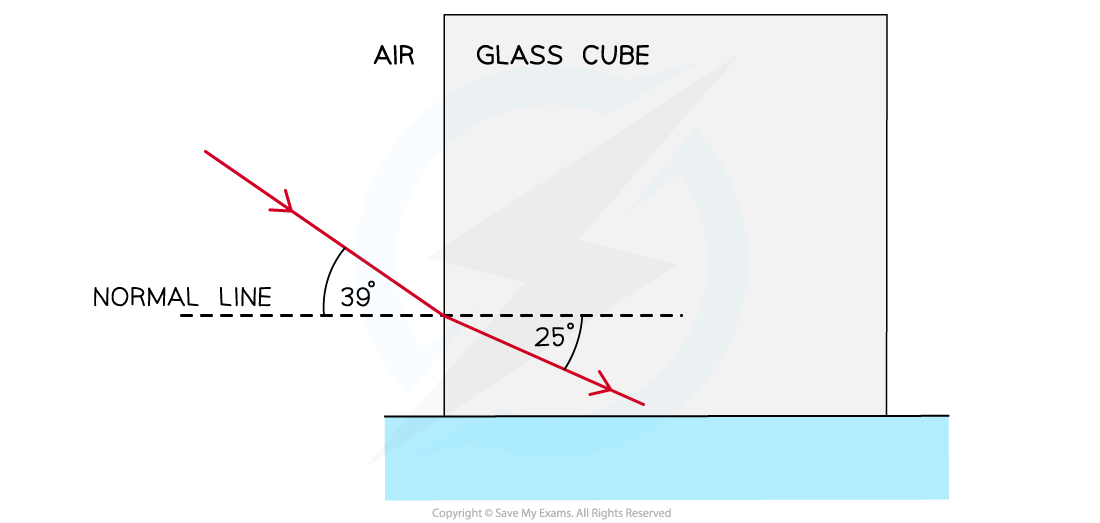
Show that the refractive index of the glass is about 1.5.
Answer:
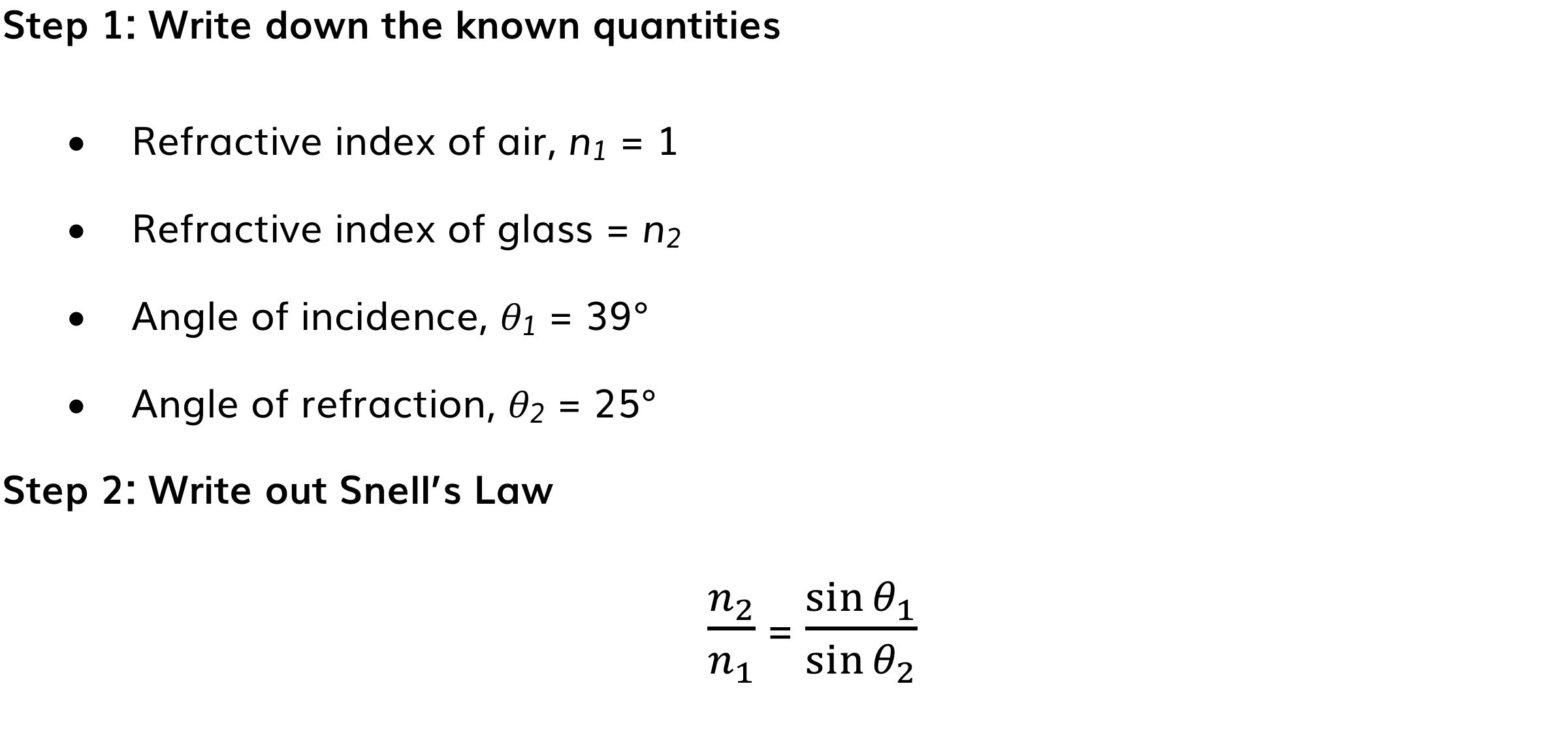

Examiner Tips and Tricks
Always double-check if your calculations for the refractive index are greater than 1. Otherwise, something has definitely gone wrong in your calculation! The refractive index of air might not be given in the question. Always assume that nair = 1
Make sure your calculator is always in degrees mode for calculating the sine of angles!
Always check that the angle of incidence and refraction are the angles between the normal and the light ray. If the angle between the light ray and the boundary is calculated instead, calculate 90 – θ (since the normal is perpendicular to the boundary) to get the correct angle
Critical Angle & Total Internal Reflection (TIR)
As the angle of incidence (i) is increased, the angle of refraction (r) also increases until it gets closer to 90°
When the angle of refraction is exactly 90° the light is refracted along the boundary between the two material
At this point, the angle of incidence is known as the critical angle θc
Critical Angle
The larger the refractive index of a material, the smaller the critical angle
When light is shone at a boundary between two materials, different angles of incidence result in different angles of refraction
As the angle of incidence is increased, the angle of refraction also increases
Until the angle of incidence reaches the critical angle
When the angle of incidence = critical angle then:
Angle of refraction = 90°
The refracted ray is refracted along the boundary between the two materials
When the angle of incidence < critical angle then:
the ray is refracted and exits the material
When the angle of incidence > critical angle then:
the ray undergoes total internal reflection
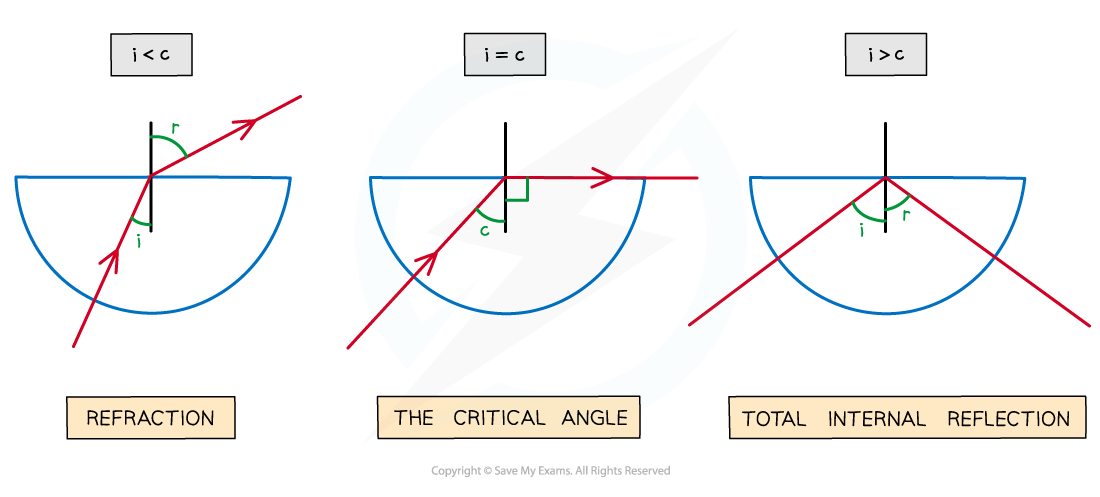
As the angle of incidence increases it will eventually exceed the critical angle and lead to the total internal reflection of the light
Critical Angle Equation
The critical angle of material 1 is found using the equation:
Where:
θc = critical angle of material 1 (°)
n1 = absolute refractive index of material 1
n2 = absolute refractive index of material 2
The two conditions for total internal reflection to occur are:
The refractive index of the second medium must be less than the refractive index of the first, n2 < n1
The angle of incidence must be greater than the critical angle, θi > θc
Total Internal Reflection
Total internal reflection is a special case of refraction that occurs when:
The angle of incidence within the denser medium is greater than the critical angle (I > θc)
The incident refractive index n1 is greater than the refractive index of the material at the boundary n2 (n1 > n2)
Total internal reflection follows the law of reflection
angle of incidence = angle of reflection
A denser medium has a higher refractive index
For example, the refractive index of glass, ng > the refractive index of air, na
Light rays inside a material with a higher refractive index are more likely to be totally internally reflected
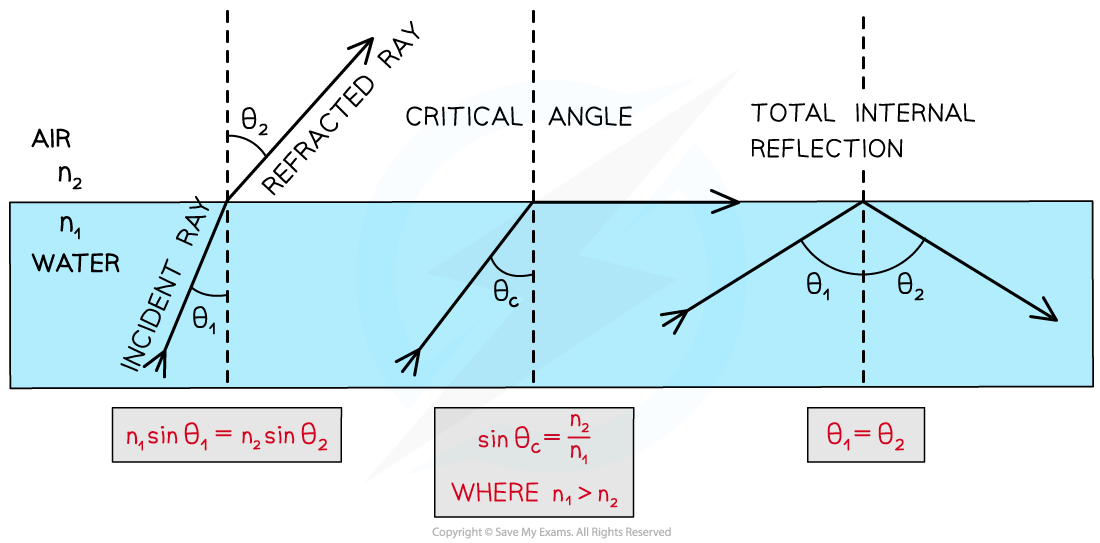
Angles of incidence, reflection and refraction to satisfy the conditions for total internal reflection
Worked Example
Light travels from a material with refractive index 1.2 into air.
Determine the critical angle of the material.
Answer:
Step 1: Write down the known quantities
Refractive index of material 1, n1 = 1.2
Refractive index of air, n2 = 1.0
Step 2: Write down the equation for the critical angle θc
Step 3: Substitute the numbers into the above equation
sinθc = 0.83
Step 4: Calculate θc by taking sin–1 of the above equation
θc = sin–1 0.83
θc = 56°
Examiner Tips and Tricks
You do not need to remember the derivation for the critical angle, but you must understand and remember the critical angle formula, as this is not given in your data booklet.

You've read 0 of your 5 free revision notes this week
Sign up now. It’s free!
Did this page help you?
